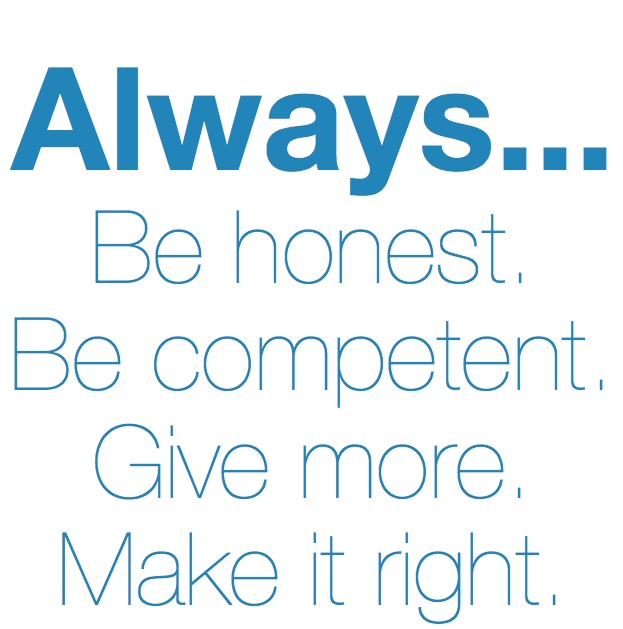274 Stop, Look And Listen: 3 Steps To Improve Your Leadership This Week
Podcast: Play in new window | Download (44.2MB)
Subscribe: Apple Podcasts | Spotify | RSS | More

What a difference a day makes? Think of the difference an entire week can make!
Leadership requires many skills. People who work in leadership development or coaching often approach the topic from various angles. I mostly focus on the aim of leadership — namely, the people being served by leaders. It may not be the coolest approach, but it’s intentional. Free from gimmicks. Most importantly, it works.
This discussion has to start with a sober consideration about humility.
Just the other day I read this about Washington Redskins’ quarterback, RG 3.
“To get better in this league, you have to have a degree of humility,” a personnel director said. “Griffin sees himself like Peyton [Manning], in that light. When he looks in the mirror, he is seeing things that everybody else is not seeing. That is why I was surprised when they gave him the fifth-year [option] and said it was an easy decision.”
I instantly resonated with it because through the years I’ve had a few clients – not many, but a few – who were leaders that lacked introspection, or humility. And I’ve observed that rare kind of leader who doesn’t hear detractors. Most of us do. I’ve experienced far more of us who hear the lone detractor even if the majority are cheering. We have an ability to hear that one lonesome person boo’ing us. Not these people. Their minds work in reverse. The vast majority can be boo’ing, but if only one person is cheering…they can only hear the cheering. I’ve long been fascinated by this ability – which honestly, is more of a curse than anything.
It’s delusion of a high order and it stymies personal growth and progress. It can wreck a team, too. When you’re already perfect improvement is tough to come by. That’s why so few of my clients suffer this malady. People who feel they need no improvement don’t go seeking out people like me. Unfortunately, sometimes for them, their bosses do. Well, they think it’s unfortunate. It’s my job to earn their trust and persuade them I’m there to help. You’d think it’d be easier than it sometimes is. I mean, stop and think about it. I’ve been commissioned to help them — how hard is it to understand that if they improve, then I look like a rockstar! It’s in MY best interest to help them. If they don’t improve, I don’t look so good.
Being Open To Suggestions
Expansion. Growth. Increases. Improvement. These are things every business owner wants.
They all mean more money. More revenues. More profits. More income. More is better!
Leaders, organizations and businesses that are not open to suggestions — ways to get better — are doomed to slip, or fail. Even if current strategies and tactics are working well, they won’t necessarily keep working well. Strategies and tactics have lifespans. Some are more durable than others.
Philosophies can last, or they can last longer.
I’ve implemented many strategies for growing business. Some have worked well. Others have been major failures.

But I’ve stuck with some core philosophies that continue to serve me well. I’ve stuck one major philosophy that has been live on my About Page for years. It has served me well because I so firmly believe in it that I refuse to deviate from it.
It’s my non-negotiable standard for doing business. It’s not some high-brow “I’m-better-than-you” deal. It’s a real-life, honest-to-goodness way of life. Yes, that means it trumps everything else. Otherwise, what good is it?
If you sell out your philosophy then you’ve got nothing other than the price you sold it for. That first word is very important. Always means always — or it doesn’t. It demands the strongest commitment.
Let’s table any thought of strategy or tactics and stay on the track of this whole philosophy. Think about YOUR philosophy. It’s important because it’s driving your strategies and tactics. It’s also important because it reveals what really matters. It speaks to our character.
So what’s your philosophy?
If I know somebody’s philosophy — and if I know that it’s non-negotiable — then I’ll know how open they’re likely to be to suggestions for growth and improvement. Oh, I know that personalities matter. A lot. But more often than not the philosophy a person crafts is going to reflect and reveal their personality.
If you’re not open to suggestions of improvement then there’s little point in having this conversation. And there’s no point in even considering alternative strategies or tactics. There certainly isn’t any point in considering any shift or change in philosophy.
Today’s 3-step strategy for leadership improvement isn’t a magic bullet for people with a closed mind. There is NO strategy for a closed mind. That’s why I’ve begun this discussion with the important factor of being open to suggestions. If that’s a problem for you, then you’d better deal with that first. Somebody else can psychoanalyze you if you need help. I’m just going to tell those of you struggling with this, figure it out so you can elevate your performance and the performance of your entire team. That ought to be enough of an upside to compel you to fix it.
 Stop.
Stop.
Texting and driving can be deadly. According to USA Today about 25% of accidents are caused by cell phone use. With more and more young drivers joining the ranks each year that number is likely going to increase, too.
Safety experts encourage all of us to slow down our texting and driving. NO THEY DON’T. They urge us to STOP.
When something isn’t working, or when something is working against us it’s the only wise option. STOP IT.
There are 2 fundamental components of this step. One is to stop doing harm. The second is to regroup, collect our thoughts and consider our options. This is why all that beginning stuff about being open was critical.
The temptation is to keep moving because too many of us mistake motion for action, accomplishment or progress. I do 3 to 4 miles a day on a treadmill. I’m stationary the entire time, but I’m moving and burning calories. Sure, I’m moving forward in my physical fitness, but geographically, I’m getting nowhere.
Too many leaders are perpetual motion machines. Lots of movement, not enough meaningful action. Some leaders don’t stop long enough to improve. These are the leaders who run around shouting, “Faster, harder. More. More. More.” It’s movement that matters. As long as they see people working, it’s good. You’d better be in your chair at 8am. And at 4:59pm.
Stop!
You can’t properly meditate or think deeply enough about improvement if you can’t (or won’t) make the time to stop. I don’t want to hear about how busy you are. Or that you can’t stop because there’s just so much going on. I’m not talking about stopping all the work. I’m talking about YOU (the leader) stopping your work. I’m talking about you putting the phone on DND (do not disturb). Shutting down your email. Closing your door. If you prefer to think of this step as PAUSE, then do it. Hit the pause button.
It’s physical, mental and emotional. That last one may be the toughest because it involves your willingness to consider and reconsider. It means you may have felt one way about things or people — and you may have it wrong. Stopping long enough to consider it can give you a fresh perspective. In an upcoming episode I’ll be talking about evidence-based leadership. That’s where your emotional conclusions aren’t purely based on how you feel about a thing or a person, but you actually have some evidence (and I don’t mean one piece of anecdotal evidence) that weighs strongly in favor of your feelings. For example, a leader can say, “I don’t trust him.” Is it based on evidence or is it purely a feeling? It’s important for leaders to avoid letting their emotions pigeonhole their opinions without any evidence to back it up. If the untrusted person has numerous specific incidents of lying, then you’ve got evidence to support you feelings of mistrust. That leads to the next step.
Look.
First, look inside yourself.
I want you to really examine one question…
Am I the problem or the solution?
I don’t mean what every member of your team thinks, but I mean what YOU think. I want you to examine your leadership and management. Look at it more carefully (and closely) than you’ve ever looked at it before.
Every leader can sometimes impact things in a negative way. Our team can see us as part of the problem because they don’t see or understand what we see and understand. Our team can see us as part of the problem if they don’t have the confidence to perform. Self-reflection is hard when you’re trying to answer the big question.
For now, ignore what your team thinks or how they feel about the answer to the question. This is about improving your leadership. It’s about improving YOU.
So think clearly and as objectively as possible. Let me help get you started.
What’s the last big thing you faced?
Think of the latest big initiative. Or the last episode involving an employee. It could be anything.
Just focus on one example. Don’t scrutinize an array of things. Think of one.
Now do a post-mortem on your involvement. How did you handle it? Consider your speed, your approach, your tone, your objective, your priorities and everything else that was going through your mind when you were in the throes of it all. Why did you do what you did? Why didn’t you do something else?
Reflect on what others did that compelled or motivated you to steer in the direction you did. Did you maintain focus during the process or did you allow yourself to be distracted by emotions? Did you worry about somebody or something that caused you to go in one direction and not another? Who was it, or what was it? Why did it get in the way?
This is the time to get out the microscope and look very closely at why you did what you did — and why you did it the way you did it.
I once did this exercise with a CEO/founder. He focused on an interaction he had with one of his direct reports that frustrated him. He began by telling me, “He’s so stubborn.” The conversation between the two men was heated because the manager was defending his department’s existence. Seems the CEO was questioning the validity of a business segment run by this manager. I sat and listened as he recounted in great detail the conversation they had.
Some 45 minutes passed with me only asking a few prompting questions along the way. When the CEO came up for air I asked, “Does this manager have a future in your company?” He seemed appalled that I’d ask and retorted, “Of course he does. The guy has been with me about 15 years.”
“Does he know he’s got a future even if you downsize or jettison his department?” I asked. “Yes, he knows he’s got a place here,” said the CEO. “How does he know? Describe that conversation for me,” I inquired.
Within seconds it dawned on him that he’d never had a conversation with this manager. In his head he’d had many conversations. He knew what he wanted to do, but he had never shared it with this direct report. BAM! He was the constraint and didn’t even know it, or know why. Until now. He’d been moving so fast and furious it never dawned on him that he hadn’t shared critical information with this valued employee. And in the process he was now beginning to build strong feelings that this guy was “so stubborn.” Maybe he was stubborn, but the reaction was spawned by being uninformed. The direct report was in the dark and he was appropriately frightened about his own future — and turns out, the future of his team.
I asked the CEO, “Do you want your leaders to care about their people?” Of course he did. It seemed to me he had a manager reporting to him who was behaving perfectly logically and ethically. He wasn’t necessarily stubborn. He was fighting for himself and his people, and he did honestly see value in the work they were doing (and the profits they were generating). But like all employees lower down the food chain, he only knew what he knew. He didn’t know what the CEO and the CEO hadn’t communicated the challenges, solutions or plans.
Let me give you one more powerful question before we move on to the last of the three action items.
What if you’re wrong?
What if that person isn’t who or what you think they are? What if that situation or circumstance isn’t what you think it is? What if things are very different?
The strongest leaders I know give themselves to regular thoughts and questions like those. But again, they’re all evidence-based leaders, too. They’re not prone to knee-jerk reactions. They don’t shoot from the hip either. It doesn’t mean they’re slow. It just means they’re deliberate. And they’re deliberate with cause.
Give yourself permission to be wrong. And be willing to acknowledge your wrongness with your team. If you want your team to own their mistakes, then you’d better get busy owning yours. A leader who refuses to acknowledge his own weaknesses or mistakes is doomed to be surrounded by people who will never vigorously debate. Such a leader will most often hear what they want, see what they want and NEVER get what they want.
Listen.
So you’ve stopped long enough to meditate and think. You’ve looked inside yourself to see what role you’re playing in solving or creating problems. Now it’s time to include others. Most notably your inner circle. Every — EVERY — successful leader has at least one person with whom they can shell things down. Some are blessed to have a few people. These are the trusted lieutenants. They are part of the executive team. You trust these people. Completely. And if you don’t, then you’re crazy for keeping them in their current role. You should be moving them along if you don’t trust them. There’s no room for untrustworthy people on your team. I don’t care if they perform with spectacular results. Without trust, you’ve got trouble. Pick which one matters most: trust or trouble.
Let’s assume you’ve got at least one person with whom you can be completely honest. You trust them completely. That doesn’t mean you tell them everything, but it means you could. You protect them from information that could unnecessarily worry them or things they have no control over. But otherwise, you rely on them for feedback, support and honesty.
I’m starting with these people because I’m hopeful you’ve got a relationship that isn’t built on telling you what you want to hear. But that may not be the case. You may be the naked emperor with nobody able to tell you how naked you really are. If so, then you’ve got more work to do than any single podcast episode can address. I’d suggest you get very busy finding a mirror — that’s at least one person at work you’re willing to be told unpleasant truths. If you’re not willing to do that, then I’m hopeful your regime comes to a quick end because you’re damaging the lives and work of others. I don’t much care how your end arrives, but the sooner the better. The world doesn’t need anymore autocratic tyrants.
Sit down with your most trusted people at work. Tell them what you’re doing. That’s right. Let them in on this exercise. Convince them you want candid honesty. Bring them up to speed with the answers you worked out on your own. Tell them that it’s only fair for you to expect improvement in yourself since that’s what you’re requiring from them, and everybody else in the organization. Persuade them that you mean it. If this is a first for you, expect resistance. They won’t likely believe you at first. Don’t strong arm them. Pretend they’re customers who must buy what you’re selling. Give them the best opportunity to buy it. It helps if you’ll own your past transgressions. If you owe them apologies, then do that upfront. Without hesitation or excuse.
Shell it all down with them. Ask them to share what they know. You need their intelligence. You need their insight.
ASK.
Before you can listen you’ve got to ask for help. This may be the first step in a process of many steps to get people to tell you what you need rather than what you want. Or what they think you want. You want the truth, but before you can get the truth you need information. You need evidence that will direct you to the truth. That means the more information you gather, from as many sources as you can, from the most trusted and reliable sources you’ve got…can lead you to the truth, or at least get you closer to it.
Train your team – your inner circle – to open up to you. This isn’t happening in front of the organization, or in front of those outside your trusted inner circle. This is you guys. Yes, there is a WE and THEM. This is the WE part of the equation. It’s you and your most trusted people working together to help you become a better leader. It’s also the most important work you’re going to do because it’s going to impact the whole organization. Your organization deserves to have the best leader possible. That’s you!
This should be the most candid, free-flowing conversation you’ve ever had with these people. You should just ask questions to provoke further conversation. Don’t attack. Don’t defend. Don’t excuse. Think like a detective. Be non-threatening. You’re their boss so you’re going to have work a lot harder at making them know they’re safe and comfortable to tell you anything!
Be honest with them. Share your concerns, fears and other weaknesses. It’s the best way to make them feel comfortable and trust you. They’ll start opening up after they know you’re willing to open up as you tell them what you’re hoping to accomplish. Just remember to shut up once you’ve got the ball rolling. Some leaders mess it up by continuing to share and they dominate the conversation. That’s not the point. This isn’t a platform for you to hold forth. It’s a platform to get them to open up with you about YOU.
I’m going to make a strong suggestion that you carve out more time than you think you’ll need. I’d encourage you to clear calendars for an entire morning or afternoon. If your organization is formal, don’t set tensions high by telling people to clear their entire afternoon for one-on-one meetings with you, or something of that order. That may heighten their anxiety. Instead, tell the people who are invited to the meeting that you want to have a very casual brainstorming conversation about some ideas that you want to share. Tell them there’s no agenda and they won’t need to bring anything with them to the meeting except their willingness to share. If you want, have snacks and soft drinks or whatever may be appropriate for the time of day. Make this very casual and non-threatening.
If you can, conduct this meeting at a round table, not a conference table with a definite head at either end. Better yet, in my experience, is to gather chairs around in a loose circle, or just you and the other person sitting by or across each other if there are just two of you. Arrange it and set it as you would the friendliest conversation you’ve ever had. You don’t want any barriers to openness.
Lose the business speak. Don’t let yourself fall into behaving or speaking like you do when you conduct a formal business meeting. Talk to these people like they’re your friends – because they are! Don’t speak to them like subordinates or direct reports. Ask them to loosen up and not think of you like their boss. Rather, plead with them to treat you like a friend who needs their help. You do need their help. Make them know how badly you want and need it. Don’t be bashful. That will defeat the point of the conversation.
This needs to be an unfiltered conversation where you’re open to whatever they have to offer – however they want to offer it. If you begin to challenge what they say, or how they say it, then they’ll stop saying anything useful. Think of this as a free-form brainstorming session without rules. Remember, these are your most trusted advisors so you don’t have to worry about anything with them.
Some leaders are fearful that such moments will destroy professional decorum in the workplace. When properly handled I’ve never seen this happen. Don’t underestimate the professionalism of these people. They’re competent people, fully capable of compartmentalizing sessions like this. I often help leaders rehearse how to begin and conduct these sessions because I know it’s not something many leaders have experience with. Most of the clients I’ve helped overthink it and fret unnecessarily about it. More often than not it’s among the most rewarding conversations the top leader has ever had. And it’s so ridiculously simple they wonder why they never did it before.
Follow up.
It’s important that you – and your team – understand the seriousness of this endeavor. This isn’t some phase you’re going through that your people have to endure. This is a very serious work project designed to have maximum positive impact on the organization. They need to understand how serious you are. Follow up is one way to demonstrate that.
Specially, you need to have another session with your inner circle. Give them a few days after the initial conversation. Schedule a second session in the same week. That way they’ve had time to huddle informally amongst themselves. They need time to have those – “What-in-the-world-got-into-her?” – conversations. This is a curve ball they’ve not seen before (assuming that you’ve not been as open with them about such things before). They also need time to distill their thoughts now that they know what this is all about.
Your first conversation was without warning. They purposefully didn’t know what the meeting was about. They just knew it was going to be an informal brainstorming session (and it was). Now they know exactly what you’re trying to accomplish. Give them some time to collect their thoughts and bring more value in the next session.
There are 2 important steps I want you to take in doing this. One, I want you to end the first session urging them to think about your goal to improve as a leader, and about the things they’ve brought up…plus the things they haven’t yet brought up. Give them one simple admonition: “I want to make sure that as I work to improve my leadership that I see and hear things accurately. So I’m going to ask you to help me gather and distill the evidence. For example, ____________________.” Give them an example of a time when you didn’t get it right. Yes, it can be one you confessed to them during the conversation, but maybe not. That’s up to you, but have one ready to use as you end the meeting. You want to leave them impressed with your commitment to “get it right.” You’re tasking them to help you do that.
Two, I want you to have a brief one-on-one with each of them. For most leaders, this is very small group. In many cases, it’s just one person. No matter, however many people comprise your inner circle, schedule a 15-minute meeting one-on-one with each of them. The sole purpose of this meeting is to make sure they’re comfortable with this process. Reiterate your seriousness to grow as their leader. And reinforce the importance in showing them by example how you hope they’ll lead, too. Sometimes you’ll learn what’s bothering them about this process, or what fears they’ve got. Address those in this brief meeting.
Conclusion
Stop. Give yourself permission and time to think about your leadership. Meditate on how things are and how you’d like them to be. Quieten down the noise in your world or you’ll never be able to see clearly.
Look. Consider your wins and your losses. I believe in soaring with your strengths, but as a leader you must eliminate (as much as possible) the constraints you bring to the workplace. Think about the places where YOU may be the problem. See things as they really are, not as you wish them to be. Accuracy matters!
Listen. Involve your closest, most trusted advisors. These are employees who serve as your inner circle. These aren’t non-work related people. Those people don’t see what your employees see. Give them a safe environment to tell you what you need to hear, not what you want to hear.
Carve out time over the course of a week to get this started. Don’t stop doing it after a week. Use the intensity of one-week to get it launched. Then, make time regularly to keep doing it. That includes scheduled times with your inner circle to discuss YOUR LEADERSHIP.
If the work inside your organization is important, then why don’t you think work on your leadership is important?
The outcome of this process will an improvement in YOU and your leadership, and the impact it will have on your entire organization. Additionally, those leaders in your inner circle will be dramatically impacted in their own careers as you urge them to avoid neglect in their own leadership growth.
Proverbs 18:24 says, “A man that hath friends must shew himself friendly.” Well, I could apply that same principle to any number of things, including growth as a leader. You must show yourself to be concerned with your leadership. That will make you a better leader. It’ll also foster higher human performance throughout your organization.

P.S. If you’d like to talk about how I might be able to help you and your team, call me at (214) 736-4406.
Subscribe to the podcast
 To subscribe, please use the links below:
To subscribe, please use the links below:
- Click Here to Subscribe via iTunes
- Click Here to Subscribe via RSS (non-iTunes feed)
- Click Here to Subscribe via Stitcher
If you have a chance, please leave me an honest rating and review on iTunes by clicking Review on iTunes. It’ll help the show rank better in iTunes.
Thank you!
274 Stop, Look And Listen: 3 Steps To Improve Your Leadership This Week Read More »



 Entropy vs. Improvement
Entropy vs. Improvement
